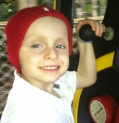Targeting Oncogenic N-MYC Complexes in High-Risk Neuroblastoma

Neuroblastoma is a childhood cancer that forms from the developing nervous system. Like many cancers, there is a wide range of long-term outcomes for neuroblastoma. For patients diagnosed with high-risk disease, treatment is intensive and includes surgery, chemotherapy, and radiation. Despite this aggressive treatment, approximately one half of all high-risk patients are not cured by current approaches. Many high-risk, treatment resistant tumors demonstrate activation of the MYCN gene. There is a gap in our ability to treat cancers driven by MYCN. To fill this gap, I recently developed a tool to identify how MYCN rewires the cell to drive neuroblastoma growth, with the goal of identifying new therapeutic targets.
Project Goal:
My goal is to identify how the MYCN gene drives aggressive neuroblastoma tumor growth and find new approaches to treat this group of patients. When genes are mutated in cancer cells, they lead to changes in the activity of proteins, which are the machines that carry out all the functions of the cell. Increased levels of MYCN in cancer cells recruit other protein machinery to drive uncontrolled cancer growth. I have developed a sensitive method to identify all the proteins that are recruited by MYCN in cancer cells. My initial efforts have identified two key proteins that MYCN recruits to drive aggressive cancer growth (named FUS and PRMT5). Both proteins have drugs that are being tested in clinical trials for human diseases, including neurodegenerative diseases and adult cancers. However, there are no trials testing these drugs in pediatric cancer. The experiments planned for this project will rigorously test how these proteins drive cancer and build a case to test these drugs in children afflicted by high-risk neuroblastoma.
Project Update 2024:
Neuroblastoma is a highly heterogeneous disease and a large number of high-risk cases are driven by tumor cell activation of a gene called MYCN. This work has identified that a specific class of drugs under development for cancer therapy, called PRMT5 inhibitors, selectively kills MYCN activated cells. We have identified the ways that PRMT5 inhibitors kill MYCN activated neuroblastoma and are laying the groundwork to justify a clinical trial fort these agents in children afflicted by these cancers. Furthermore, by understanding how these drugs work, we are studying how to combine PRMT5 inhibitors with other cancer therapies.

